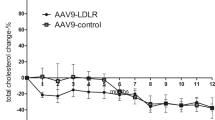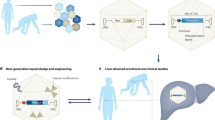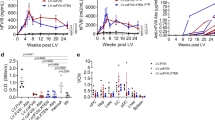Abstract
Autosomal dominant familial hypercholesterolemia (FH) is a monogenic life-threatening disease. We tested the efficacy of low-density lipoprotein receptor (LDLR) gene therapy using helper-dependent adenoviral vector (HDAd) in a nonhuman primate model of FH, comparing intravenous injection versus intrahepatic arterial injection in the presence of balloon catheter-based hepatic venous occlusion. Rhesus monkeys heterozygous for mutant LDLR gene (LDLR+/−) developed hypercholesterolemia while on a high-cholesterol diet. We treated them with HDAd-LDLR either by intravenous delivery or by catheter-based intrahepatic artery injection. Intravenous injection of ⩽1.1 × 1012 viral particles (vp) kg−1 failed to have any effect on plasma cholesterol. Increasing the dose to 5 × 1012 vp kg−1 led to a 59% lowering of the plasma cholesterol that lasted for 30 days before it returned to pre-treatment levels by day 40. A further increase in dose to 8.4 × 1012 vp kg−1 resulted in severe lethal toxicity. In contrast, direct hepatic artery injection following catheter-based hepatic venous occlusion enabled the use of a reduced HDAd-LDLR dose of 1 × 1012 vp kg−1 that lowered plasma cholesterol within a week, and reached a nadir of 59% pre-treatment level on days 20–48 after injection. Serum alanine aminotransferase remained normal until day 48 when it went up slightly and stayed mildly elevated on day 72 before it returned to normal on day 90. In this monkey, the HDAd-LDLR-induced trough of hypocholesterolemia started trending upward on day 72 and returned to pre-treatment levels on day 120. We measured the LDL apolipoprotein B turnover rate at 10 days before, and again 79 days after, HDAd-LDLR treatment in two monkeys that exhibited a cholesterol-lowering response. HDAd-LDLR therapy increased the LDL fractional catabolic rate by 78 and 50% in the two monkeys, coincident with an increase in hepatic LDLR mRNA expression. In conclusion, HDAd-mediated LDLR gene delivery to the liver using a balloon catheter occlusion procedure is effective in reversing hypercholesterolemia in a nonhuman primate FH model; however, the unsustainability of the hypocholesterolemic response during 3–4 months of follow up and heterogeneous response to the treatment remains a challenge.
This is a preview of subscription content, access via your institution
Access options
Subscribe to this journal
Receive 12 print issues and online access
$259.00 per year
only $21.58 per issue
Buy this article
- Purchase on Springer Link
- Instant access to full article PDF
Prices may be subject to local taxes which are calculated during checkout






Similar content being viewed by others
References
Rader DJ, Cohen J, Hobbs HH . Monogenic hypercholesterolemia: new insights in pathogenesis and treatment. J Clin Invest 2003; 111: 1795–1803.
Hovingh GK, Davidson MH, Kastelein JJ, O'Connor AM . Diagnosis and treatment of familial hypercholesterolaemia. Eur Heart J 2013; 34: 962–971.
Chowdhury JR, Grossman M, Gupta S, Chowdhury NR, Baker Jr JR, Wilson JM . Long-term improvement of hypercholesterolemia after ex vivo gene therapy in LDLR-deficient rabbits. Science 1991; 254: 1802–1805.
Grossman M, Raper SE, Kozarsky K, Stein EA, Engelhardt JF, Muller D et al. Successful ex vivo gene therapy directed to liver in a patient with familial hypercholesterolaemia. Nat Genet 1994; 6: 335–341.
Grossman M, Rader DJ, Muller DW, Kolansky DM, Kozarsky K, Clark BJ 3rd et al. A pilot study of ex vivo gene therapy for homozygous familial hypercholesterolaemia. Nat Med 1995; 1: 1148–1154.
Bilheimer DW, Goldstein JL, Grundy SM, Brown MS . Reduction in cholesterol and low density lipoprotein synthesis after portacaval shunt surgery in a patient with homozygous familial hypercholesterolemia. J Clin Invest 1975; 56: 1420–1430.
Brown MS, Goldstein JL, Havel RJ, Steinberg D . Gene therapy for cholesterol. Nat Genet 1994; 7: 349–350.
Kim IH, Jozkowicz A, Piedra PA, Oka K, Chan L . Lifetime correction of genetic deficiency in mice with a single injection of helper-dependent adenoviral vector. Proc Natl Acad Sci USA 2001; 98: 13282–13287.
Nomura S, Merched A, Nour E, Dieker C, Oka K, Chan L . Low-density lipoprotein receptor gene therapy using helper-dependent adenovirus produces long-term protection against atherosclerosis in a mouse model of familial hypercholesterolemia. Gene Therapy 2004; 11: 1540–1548.
Li R, Chao H, Ko KWS, Cormier S, Dieker C, Nour EA et al. Gene therapy targeting LDL cholesterol but not HDL cholesterol induces regression of advanced atherosclerosis in a mouse model of familial hypercholesterolemia. J Genet Syndr Gene Ther 2011; 2: 106.
Yin W, Carballo-Jane E, McLaren DG, Mendoza VH, Gagen K, Geoghagen NS et al. Plasma lipid profiling across species for the identification of optimal animal models of human dyslipidemia. J Lipid Res 2011; 53: 51–65.
Morris MD, Fitch CD . Spontaneous hyperlipidemia in rhesus monkey. Biochem Med 1968; 2: 209–215.
Lee JA, Morris MD . Characterization of the serum low-density lipoproteins of normal and two rhesus monkeys with spontaneous hyperbeta-lipoproteinemia. Biochem Med 1974; 10: 245–257.
Hummel M, Li ZG, Pfaffinger D, Neven L, Scanu AM . Familial hypercholesterolemia in a rhesus monkey pedigree: molecular basis of low density lipoprotein receptor deficiency. Proc Natl Acad Sci USA 1990; 87: 3122–3126.
Goldstein JL, Brown MS . The LDL receptor. Arterioscler Thromb Vasc Biol 2009; 29: 431–438.
Scanu AM, Khalil A, Neven L, Tidore M, Dawson G, Pfaffinger D et al. Genetically determined hypercholesterolemia in a rhesus monkey family due to a deficiency of the LDL receptor. J Lipid Res 1988; 29: 1671–1681.
Brunetti-Pierri N, Stapleton GE, Law M, Breinholt J, Palmer DJ, Zuo Y et al. Efficient, long-term hepatic gene transfer using clinically relevant HDAd doses by balloon occlusion catheter delivery in nonhuman primates. Mol Ther 2009; 17: 327–333.
Brunetti-Pierri N, Liou A, Patel P, Palmer D, Grove N, Finegold M et al. Balloon catheter delivery of helper-dependent adenoviral vector results in sustained, therapeutic hFIX Expression in rhesus macaques. Mol Ther 2012; 20: 1863–1870.
Brunetti-Pierri N, Palmer DJ, Beaudet AL, Carey KD, Finegold M, Ng P . Acute toxicity after high-dose systemic injection of helper-dependent adenoviral vectors into nonhuman primates. Hum Gene Ther 2004; 15: 35–46.
Manno CS, Pierce GF, Arruda VR, Glader B, Ragni M, Rasko JJ et al. Successful transduction of liver in hemophilia by AAV-Factor IX and limitations imposed by the host immune response. Nat Med 2006; 12: 342–347.
Leen AM, Christin A, Khalil M, Weiss H, Gee AP, Brenner MK et al. Identification of hexon-specific CD4 and CD8 T-cell epitopes for vaccine and immunotherapy. J Virol 2008; 82: 546–554.
Kassim SH, Li H, Vandenberghe LH, Hinderer C, Bell P, Marchadier D et al. Gene therapy in a humanized mouse model of familial hypercholesterolemia leads to marked regression of atherosclerosis. PLoS One 2010; 5: e13424.
Chen SJ, Sanmiguel J, Lock M, McMenamin D, Draper C, Limberis MP et al. Biodistribution of AAV8 vectors expressing human low-density lipoprotein receptor in a mouse model of homozygous familial hypercholesterolemia. Hum Gene Ther Clin Dev 2013; 24: 154–160.
Brunetti-Pierri N, Stapleton GE, Palmer DJ, Zuo Y, Mane VP, Finegold MJ et al. Pseudo-hydrodynamic delivery of helper-dependent adenoviral vectors into non-human primates for liver-directed gene therapy. Mol Ther 2007; 15: 732–740.
Nathwani AC, Tuddenham EG, Rangarajan S, Rosales C, McIntosh J, Linch DC et al. Adenovirus-associated virus vector-mediated gene transfer in hemophilia B. N Engl J Med 2011; 365: 2357–2365.
Perreau M, Kremer EJ . Frequency, proliferation, and activation of human memory T cells induced by a nonhuman adenovirus. J Virol 2005; 79: 14595–14605.
Calcedo R, Vandenberghe LH, Roy S, Somanathan S, Wang L, Wilson JM . Host immune responses to chronic adenovirus infections in human and nonhuman primates. J Virol 2009; 83: 2623–2631.
McCoy K, Tatsis N, Korioth-Schmitz B, Lasaro MO, Hensley SE, Lin SW et al. Effect of preexisting immunity to adenovirus human serotype 5 antigens on the immune responses of nonhuman primates to vaccine regimens based on human- or chimpanzee-derived adenovirus vectors. J Virol 2007; 81: 6594–6604.
Shayakhmetov DM, Di Paolo NC, Mossman KL . Recognition of virus infection and innate host responses to viral gene therapy vectors. Mol Ther 2010; 18: 1422–1429.
Cerullo V, Seiler MP, Mane V, Brunetti-Pierri N, Clarke C, Bertin TK et al. Toll-like receptor 9 triggers an innate immune response to helper-dependent adenoviral vectors. Mol Ther 2007; 15: 378–385.
Appledorn DM, Patial S, McBride A, Godbehere S, Van Rooijen N, Parameswaran N et al. Adenovirus vector-induced innate inflammatory mediators, MAPK signaling, as well as adaptive immune responses are dependent upon both TLR2 and TLR9 in vivo. J Immunol 2008; 181: 2134–2144.
VanderLaan PA, Reardon CA, Getz GS . Site specificity of atherosclerosis: site-selective responses to atherosclerotic modulators. Arterioscler Thromb Vasc Biol 2004; 24: 12–22.
Kassim SH, Li H, Bell P, Somanathan S, Lagor W, Jacobs F et al. Adeno-associated virus serotype 8 gene therapy leads to significant lowering of plasma cholesterol levels in humanized mouse models of homozygous and heterozygous familial hypercholesterolemia. Hum Gene Ther 2013; 24: 19–26.
Horton JD, Cohen JC, Hobbs HH . PCSK9: a convertase that coordinates LDL catabolism. J Lipid Res 2009; 50 (Suppl): S172–S177.
Koren MJ, Lundqvist P, Bolognese M, Neutel JM, Monsalvo ML, Yang J et al. Anti-PCSK9 monotherapy for hypercholesterolemia: the MENDEL-2 randomized, controlled phase III clinical trial of evolocumab. J Am Coll Cardiol 2014; 63: 2531–2540.
Stroes E, Colquhoun D, Sullivan D, Civeira F, Rosenson RS, Watts GF et al. Anti-PCSK9 antibody effectively lowers cholesterol in patients with statin intolerance: the GAUSS-2 randomized, placebo-controlled phase 3 clinical trial of evolocumab. J Am Coll Cardiol 2014; 63: 2541–2548.
Robinson JG, Nedergaard BS, Rogers WJ, Fialkow J, Neutel JM, Ramstad D et al. Effect of evolocumab or ezetimibe added to moderate- or high-intensity statin therapy on LDL-C lowering in patients with hypercholesterolemia: the LAPLACE-2 randomized clinical trial. JAMA 2014; 311: 1870–1882.
Stein EA, Gipe D, Bergeron J, Gaudet D, Weiss R, Dufour R et al. Effect of a monoclonal antibody to PCSK9, REGN727/SAR236553, to reduce low-density lipoprotein cholesterol in patients with heterozygous familial hypercholesterolaemia on stable statin dose with or without ezetimibe therapy: a phase 2 randomised controlled trial. Lancet 2012; 380: 29–36.
Stein EA, Swergold GD . Potential of proprotein convertase subtilisin/kexin type 9 based therapeutics. Curr Atheroscler Rep 2013; 15: 310–323.
Marais AD, Raal FJ, Stein EA, Rader DJ, Blasetto J, Palmer M et al. A dose-titration and comparative study of rosuvastatin and atorvastatin in patients with homozygous familial hypercholesterolaemia. Atherosclerosis 2008; 197: 400–406.
Soutschek J, Akinc A, Bramlage B, Charisse K, Constien R, Donoghue M et al. Therapeutic silencing of an endogenous gene by systemic administration of modified siRNAs. Nature 2004; 432: 173–178.
Zimmermann TS, Lee AC, Akinc A, Bramlage B, Bumcrot D, Fedoruk MN et al. RNAi-mediated gene silencing in non-human primates. Nature 2006; 441: 111–114.
Koornneef A, Maczuga P, van Logtenstein R, Borel F, Blits B, Ritsema T et al. Apolipoprotein B knockdown by AAV-delivered shRNA lowers plasma cholesterol in mice. Mol Ther 2011; 19: 731–740.
Maczuga P, Verheij J, van der Loos C, van Logtenstein R, Hooijer G, Martier R et al. Therapeutic expression of hairpins targeting apolipoprotein B100 induces phenotypic and transcriptome changes in murine liver. Gene Therapy 2014; 21: 60–70.
Palmer D, Ng P . Improved system for helper-dependent adenoviral vector production. Mol Ther 2003; 8: 846–852.
Li R, Paul A, Ko KW, Sheldon M, Rich BE, Terashima T et al. Interleukin-7 induces recruitment of monocytes/macrophages to endothelium. Eur Heart J 2012; 33: 3114–3123.
Leen AM, Sili U, Vanin EF, Jewell AM, Xie W, Vignali D et al. Conserved CTL epitopes on the adenovirus hexon protein expand subgroup cross-reactive and subgroup-specific CD8+ T cells. Blood 2004; 104: 2432–2440.
Leen AM, Myers GD, Sili U, Huls MH, Weiss H, Leung KS et al. Monoculture-derived T lymphocytes specific for multiple viruses expand and produce clinically relevant effects in immunocompromised individuals. Nat Med 2006; 12: 1160–1166.
Kushwaha RS, Barrett PH, Reardon CA, Lewis DS, Carey KD, Getz GS et al. Relationships of plasma and hepatic variables with rates of plasma low-density lipoprotein apolipoprotein B metabolism in baboons fed low- and high-fat diets. Metabolism 1995; 44: 1058–1066.
Acknowledgements
We thank Drs ML Brenner and SL Samson for valuable discussion and Dr MA Law, Dr GE Stapleton, EA Nour, S Cormier, R Razook, G Cody and S Wang for technical assistance. This work was supported by HL059314, HL51586 and P30-DK079638.
Author information
Authors and Affiliations
Corresponding author
Ethics declarations
Competing interests
The authors declare no conflict of interest.
Additional information
Supplementary Information accompanies this paper on Gene Therapy website
Supplementary information
Rights and permissions
About this article
Cite this article
Oka, K., Mullins, C., Kushwaha, R. et al. Gene therapy for rhesus monkeys heterozygous for LDL receptor deficiency by balloon catheter hepatic delivery of helper-dependent adenoviral vector. Gene Ther 22, 87–95 (2015). https://doi.org/10.1038/gt.2014.85
Received:
Revised:
Accepted:
Published:
Issue Date:
DOI: https://doi.org/10.1038/gt.2014.85
This article is cited by
-
Helper-dependent adenovirus-mediated gene transfer of a secreted LDL receptor/transferrin chimeric protein reduces aortic atherosclerosis in LDL receptor-deficient mice
Gene Therapy (2019)
-
Gene therapy with helper-dependent adenoviral vectors: lessons from studies in large animal models
Virus Genes (2017)
-
Management of patients with familial hypercholesterolaemia
Nature Reviews Cardiology (2015)



